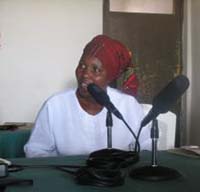Rwandan exhibit is centerpiece of new national archive
One of the casualties of the 1994 Rwandan genocide was the culture’s storytelling tradition. Resurrecting it has been the mission of a project called Stories for Hope for the past four years.
Now 99 narratives—conversations between youths and elders—will go on exhibit at the newly built Rwandan National Archives, which were decimated during the violence. On Oct. 12, the archives opened again for the first time in nearly two decades.
Resilience and Redemption

Mukakayange Veronique trains Stories for Hope facilitators in Rwanda. (Photo courtesy of Patricia Pasick.)
Stories for Hope Rwanda is a storytelling project founded by U-M alumna Patricia Pasick, PhD, a psychologist who sought to bring young people and elders together to talk about the past across generations. It was a creative and ultimately therapeutic way to break the silence that has fallen since the Rwandan genocide. She joined forces with David Wallace, a lecturer and research investigator at U-M’s School of Information, to develop the project in a style similar to StoryCorps. Stories for Hope lets a Rwandan young person invite an elder to have an audio-recorded dialogue to learn more about the elder’s personal past, Rwanda’s history, or its culture.
Rwandan facilitators encourage elders to tell stories that underscore their strength and resilience, as a way to help young people find positive pathways forward, project founders say. The conversations are in native language and translated later into English.
The genocide was the impetus for the project. But it’s not the only topic of the conversations within it, says Wallace.
“Participants are free to talk about the genocide and often do, but that’s not the sole purpose,” he says. “Most of the silences between the generations can be laid at the door of the genocide.
“Elders became unwilling to open the vault of their personal pasts for fear of inflicting painful stories. Young people sensed those fears and withheld their questions. A pact of silence grew up around most any story about the past.”
The Spoken Word
Questions about family and work history, marriage practices, and Rwandan culture are as common as questions about the genocide, says Pasick. She cites an experience with one young woman who seemed nervous before a session with an uncle. Pasick braced for a difficult debriefing after her dialogue.

Patricia Pasick, founder of Stories for Hope, talks about the project with Kanamugire Theophile, director of a local NGO in Nyamata, Rwanda. (Photo courtesy of Patricia Pasick.)
“It turns out she had a simple question,” Pasick says. “She wanted to get married to a young man and she needed to ask her uncle how she could possibly get married if the young man didn’t have a cow to give to her family. She feared she could never marry him because he was so poor. The uncle said, ‘That was then. You can go along with your wedding.'”
In other stories: A widowed mother tells her son for the first time who his father was, how they became estranged, and how he died. But she encourages him to ask more questions and reassures him the genocide won’t happen again.
A father tells his son how his life went off track, from alcohol, and how he hid the family in a forest during the genocide to resist joining a killing group. The son was immensely relieved. He had assumed his father was a perpetrator.

Youths and elders create audio-recorded dialogues. (Photo courtesy of Patricia Pasick.)
A young man tells a friend how he was hurt both physically and emotionally when a neighbor he knew well threw a grenade at him. He encourages his friend to share her own story. Participating in Stories for Hope eventually led the young man to visit the neighbor in prison 15 years later after the attack. The two reconciled.
“They come together in a cloistered sanctuary,” Pasick says. “We say, ‘You have an hour. Young person, ask what questions you’ve always wanted to ask. Elder, make sure that you tell a story that you think this person really needs to hear to go off into the future with some hope.’ These one-hour discussions catalyze many more hours of talking at home or in the neighborhood.”
Healing and Hope
For the people who took part in Stories for Hope and for those who listen, whether in Rwanda or beyond, Pasick and Wallace hope the project can link the past and future in a constructive way.
“The past can be a place of great pain and a place of great learning. It can help to enhance our own humanity because these primary materials can connect you with people in a way that nothing else can,” Wallace says.
The dialogues, and their place in the Rwandan National Archives, send a strong message of resilience to Pasick.
“The stories say this: We survived to a point where we are intent on preserving what happened as a way of not repeating it,” she says.
The Stories for Hope permanent exhibit will be an interactive listening station—a table, four chairs, two CD players with headphones, and a catalog of CDs, along with two informational panels and an invitation to participate. Many of the stories are posted at the Stories for Hope website.



